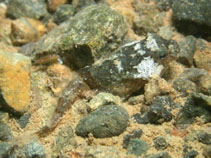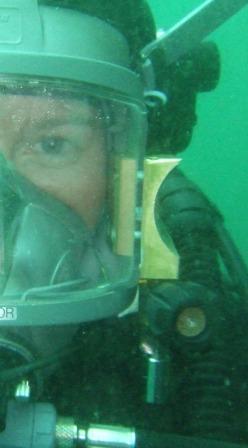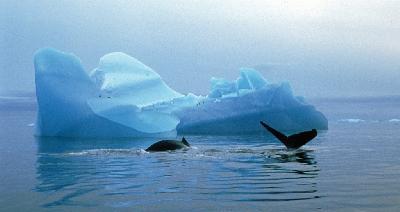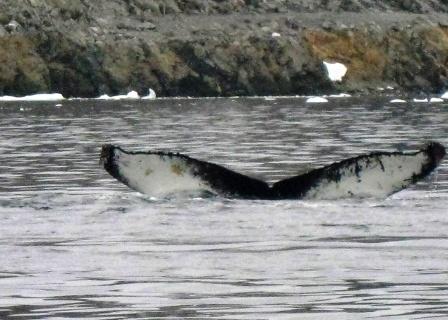Emperor Penguin
This is a lone Emperor Penguin that sat on a berg at the end of the runway for two days at Rothera. Emperor Penguins are rarely seen here maybe once or twice a year because there are no big colonies around here. They swim for miles and miles feeding but don’t necessarily stay together. The one that visited us is a juvenile which Danny the other boatman says you can tell by plummage so they aren’t drawn to the breeding colonies.
The first month I was in Antarctica I went out on a aerial photography flight as co pilot and took pictures of an Emperor Penguin colony on the east side of the peninsula from 2500 feet with my SLR. The pictures are being used by National Geographic – what is amazing is that you can see each individual penguin on my 10MB camera!
Emperor penguins are the largest of all the penguins. They stand almost 4 ft. (1.2 meters) tall and weigh 70 to 90 lbs. (30 to 40 kg.). They live and breed at the beginning of winter, on the fast ice all around the Antarctic continent. The total population is estimated to be about 200,000 breeding pairs. Emperor penguins can mate when they are 4 years old and can live to be 20 years of age.
Emperors live in the coldest climate on earth. Temperatures can drop as low as -140 degrees Fahrenheit (-60 degrees Celsius) on the Antarctic ice. After mating, the female lays one large egg. The egg is then immediately rolled to the top of the male’s feet. The egg is then incubated or kept warm on the male’s feet by a thick fold of skin that hangs from the belly of the male. The males manage to survive by standing huddled in groups for up to 9 weeks. During this time the female returns to the open sea to feed. During the time the male incubates the egg, he may lose about half his body weight because he does not eat.
The shape of their body helps them to survive. They have short wings that help them to dive up to 900 feet to catch larger fish. They can swim 10-15 kilometers an hour which lets them escape their main enemy, the leopard seal. They can stay warm because they have a thick layer of down under the outer feathers and a layer of blubber. The layer of downy feathers trap air that keeps the body heat in and cold air and water out. They also have large amounts of body oil that aids in keeping them dry in the water.
Catching Paraceradocus
Paraceradocus are basically little brown shrimpy things that live in algae and under rocks and grow to about 2cm in length living in shallows and at depth.
When Terri and I go diving for them she will lift the rocks and pick them up and I am right next to her with a tub with a lid and I open up the lid hopefully not letting out any of the contents and capture the little thing then quickly close the lid. It makes a difference if you work as a team as it is quicker than having to catch the little thing and then try to open the tub and get them in!
The shrimps are used in thermal limit experiments which means their respiration etc. is measured as they are warmed up. Basically their survival depends on how quickly they are warmed up but most perish at 2C increase in temperature so in the case of sea temperature rising by 2C they most likely would not survive.
Crane launching
The normal method of launching the RIBs is to use the ‘Noddy’ or Nodwell Crane off the wharf and then using the rope ladder to get down to the boat. The only problem we have is when we have a southerly or easterly which creates bad swell conditions at the wharf. Now and again we will also have a large iceberg in the way but with the current which swirls around Ryder Bay we can normally wait for a while and it has moved clear.
Half Marathon
Sunday was a great day. A bit of a lie in followed by cooking oatmeal and raisen cookies and chocolate chip cookie bars for the 112 people currently on base. Then Clive and I went skinning up towards the caboose and I got a call to go flying. So I turned around back to base and jumped into flight clothes. Off I flew with Alan in the twin otter to pick up a load from the Larissa project. It was a beautiful flight and I even got to land on the ski way on the skies while I was talked down. The pilots here are awesome.
I am off this morning to the field to stay at Fossil Bluff for a week. I have blog posting scheduled but I am not making them from the field.
While I am at Fossil Bluff the Rothera half marathon is going on to raise money for the East Anglia Children’s Hospice. I am taking Field Skis and instead will be sking a half marathon so please dig deep for terminally ill children.
http://www.justgiving.com/rotherahalfmarathon
Open Mic Night
For the second time this season we had open mic night last night.
Mel, Tris and Ant
Justin and Webbo
Ewan and Ant playing a song Ewan learnt in South Africa growing up. He was taught it by his fathers batman (father was chief of police) who was murdered for working for a white family.
Above is Clive and Ant playing duelling banjos.
Harpagifer Antarcticus
 Little antarctic fish (max length 9.5cm) basically that can be caught by divers as they aren’t really that fast. We haven’t been catching them for experiments however, on a dive a few weeks ago Terri handed one to me to look at and when I put it back down it got captured by a nearby anemone and when we left it was being eaten. The one I saw was a lot more colorful than the one in the above picture.
Little antarctic fish (max length 9.5cm) basically that can be caught by divers as they aren’t really that fast. We haven’t been catching them for experiments however, on a dive a few weeks ago Terri handed one to me to look at and when I put it back down it got captured by a nearby anemone and when we left it was being eaten. The one I saw was a lot more colorful than the one in the above picture.
Bail out…

The knob in the bottom right corner of the above picture is what I turn in an emergency when I am diving. On my BCD there are two bottles mounted one I use as a working tank and the buddy bottle is my emergency supply. The air from the buddy bottle will just freeflow into my full face mask and I can then slowly and safely surface.
Humpbacks

We have had humpbacks in Ryder Bay over the last month they really are graceful and magnificant. They grow up to 52 feet and weigh up to 76,000lbs. They are loved at Rothera because they often breach and show their tail flukes and also they will sing which is thought to be a mating call. Their singing will go on for 10-20 minutes. They migrate up to 25,000km a year coming down to Antarctica to feed on krill and small fish during the Antarctic winter they move north and live off their fat reserves not eating but breeding.

On our return from Leonie summit we sat next to three humpbacks and watched them lunge feeding. It was unusual as they were in 35-50m of water in between lagoon and anchorage when we started watching them. There were three and they would come up for 6 breaths at the surface and then dive showing us their flukes and feed before returning to the surface about 5 minutes later to take some big breaths again.
Today’s fun
Boat/dive meeting board this morning
Going in for my birthday dive at Anchorage – a great wall dive.
In the bath tub in the dive store. The family tradition even gets to Antarctica except this was full of -1C salt water from the Aquarium.
Roping up
All kitted up ready to hit the hills!
Where the risk of crevassing exists we have to be roped together as an Alpine pair. The picture above is the equipment we carry for being able to rescue your partner if they go down a creavasse. Two snow stakes, ice axe, ice hammer, harness, a 50 meter dynamic climbing rope, jingly janglies (13 different caribeners with lots of different tools), a climbing helmet, backpack, crampons to fit on plastic mountaineering boots and of course a backpack with first aid kit, extra gloves and warm clothes, water and food.
This is Clive and I roping up we have walked away from each other in order to divide the rope into three. We then carry a third of the rope around each of us in coils and are connected by a third of the rope. This ensures a gap of 10meters or more between each person and allows us to have sufficient rope to set up a system of rescuing our partner out of a crevasse.
On Sunday we climbed Badger’s Butress which had amazing views to the mountains on Alexander Island over 100 miles away. Around my body I am carrying 1/3 of the rope in coils which shortens the rope and creates a chest harness so that I would hang the right way up if I fell in a crevasse.
At the end of our little climb it was fun making a snow angel! I have to admit to lI am looking forward to rolling around in a carpet of green grass.

